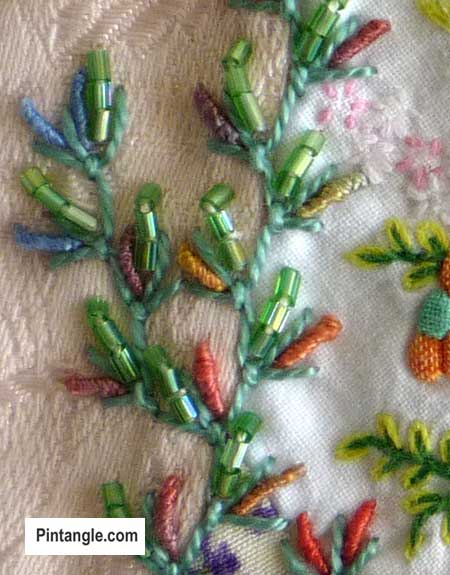
People either love or hate bullion knots but I am in the love them camp! They are one of those hand-embroidery stitches that can be tricky to work so if you have trouble with them do take time to read my tips.
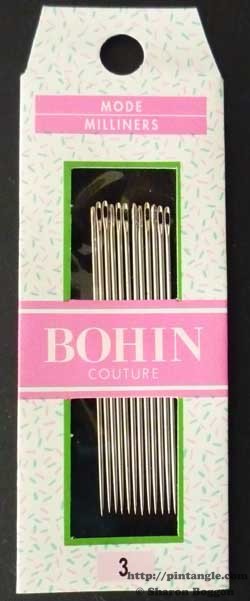
Tips before you start Bullion Knot stitch
The main problem associated with working bullion knots is that people use the wrong needle. I suggest you try milliners or straw needles. Why these particular needles? Most embroidery needles have an eye that is wider than the shaft of the needle, which means any stitch that wraps the thread around the needle often runs the risk of getting too tight to pull the thread through.
Milliners or straw needles have an eye and shaft of the same width, which makes sliding the wrapped bullion knot along the needle easy. Try it, as it does make a difference!
Where do you get Milliners needles? Specialist needlework shops will or should stock them. If you are not near a needlework store, you can buy Milliners Needles online (this is an affiliate link which means if you shop here I get a small commission but that is not why I recommend them!)
Another tip is to wrap your thread in a clockwise direction. For most threads, this will mean you will follow the natural twist of the direction in which it was spun. If your thread untwists as you wrap your bullion, it means the thread was spun in the opposite direction to most threads on the market. This would include some rayon threads. In this case, wrap your bullion in an anti-clockwise direction.
Simply put, wrap clockwise most of the time but if for some reason this untwists your thread wrap anti-clockwise.
If you have trouble with stranded threads getting a tangle, try a twisted thread like cotton perle #8 0r #5.
Some people get a little tense and wrap too tight. Then, while still on the needle hold the bullion between thumb and first finger and gently rub the bullion back and forth in your fingers to loosen the wraps slightly before you pull the needle through.
Also, stretch the fabric in a needlework hoop or frame so that you have both hands free to work the knot. If you need advice on wrapping a hoop and what size to choose, skip over to this tutorial on how to bind and use an embroidery hoop.
When you start to use bullion knots in your embroidery, start with a simple 4 or 5 wrap bullion. Then, as you master those, add more wraps.

Bullion knot is also known as bullion stitch, caterpillar stitch, coil stitch, grub knot, knot stitch, post stitch, Porto Rico rose and worm stitch.
How to work Bullion Knots
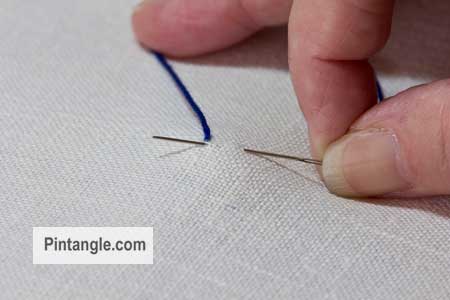
Bring the thread from the back of the fabric and insert the needle a short space away, pointed towards the place that the thread emerges from the fabric. The distance between these two points determines the length of the knot.
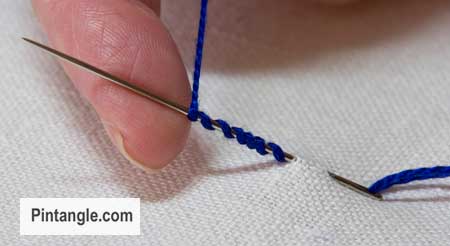
Wrap the thread around the needle five or six times. Do not cross the wraps on the needle, instead, make sure the thread coils up the needle. The coil of thread on the needle should be the same length as the distance between where the needle emerges and exits the fabric.
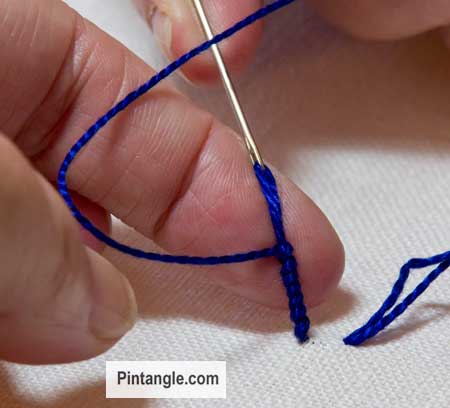
Pull the needle through the coil, while holding the coil between your first finger and thumb. See the photo below. This grip of the coil will keep the bullion knot smooth and prevent it from knotting in on itself. Pull the working thread up and away from you.
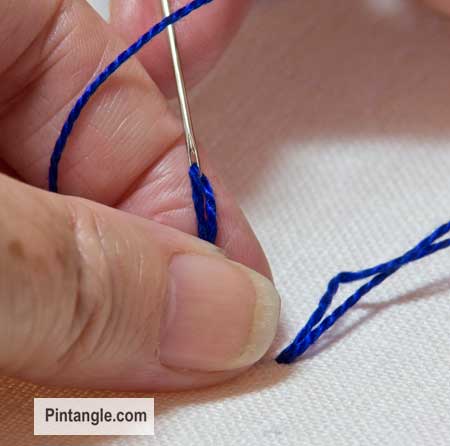
As the coil tightens, change the direction that you are pulling the thread and pull it to towards you.
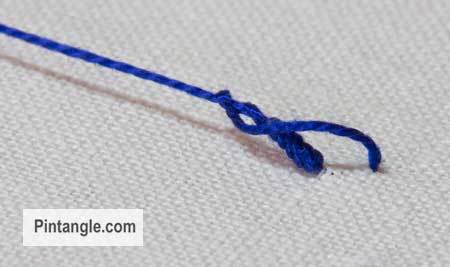
If the bullion bunches or looks untidy pass the needle under the bullion and rub it up and down the length of the bullion to smooth the coils out. Stitchers call this ‘rubbing the belly’ of the bullion.
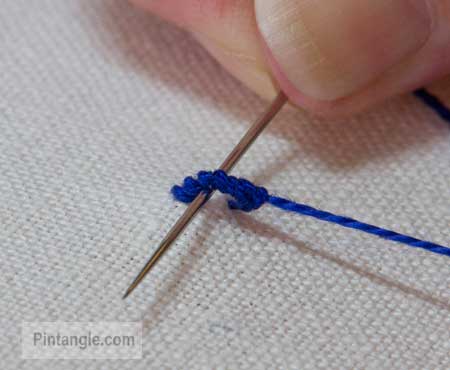

When smooth, take the needle through the fabric at the point where the thread first emerged. The coil of thread — which is the bullion knot — should now lie neatly on the surface.
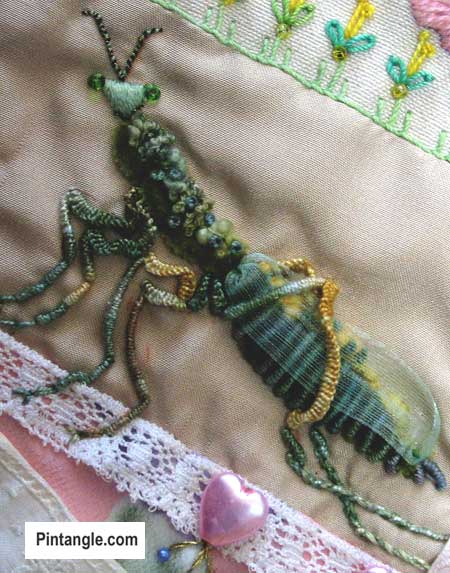
There are many applications for this stitch. For example, the body of this praying mantis is made up of Bullion knots.
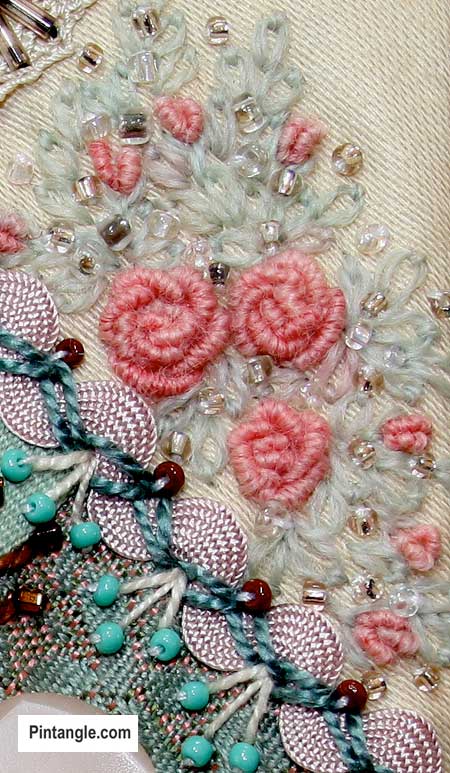
You can also make hand embroidered bullion roses. I worked these in wool.
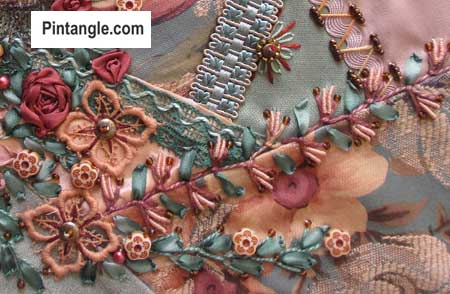
When you combine bullion knots in floral sprays, they can be very effective. In this sample, I tucked them between the forks of Alternating Up and Down Buttonhole
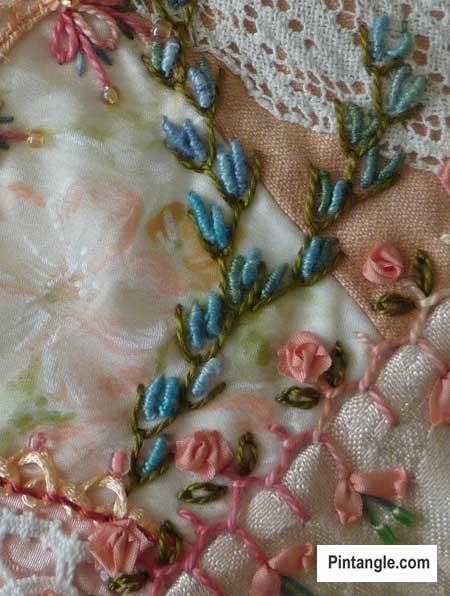
Bullion Knots are ideal to tuck into the fork of feather stitch and its varieties.
Here is a small seam I covered with feather stitch on Block 77 on my I Dropped the Button Box Quilt. I added Bullion Knots across the top of the bar. I created both the feather stitch and the bullions using cotton perle # 5 thread.

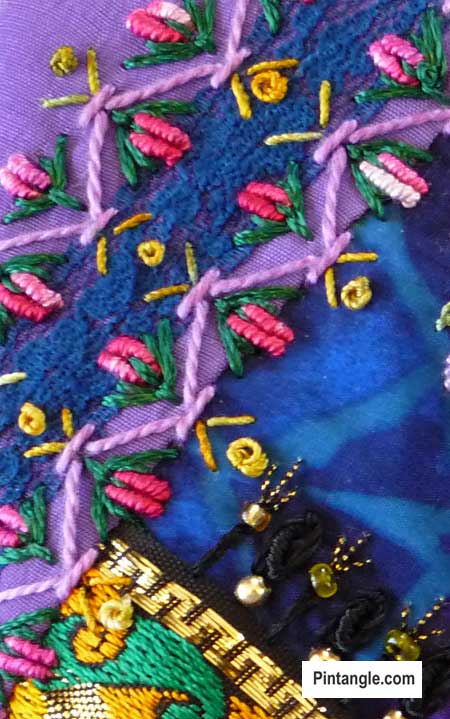
Crazy quilters love this stitch, as it can add texture to a seam or band of embroidery.

Here bullions of 25 wraps surround beads. You can see the block where this detail sits here on Crazy Quilt Block 78
Bullion Knot is one of those hand embroidery stitches that is fun and interesting. Once mastered, they are fun. I know they do take a little practice but they are well worth learning and enjoying!
Thread Twisties!
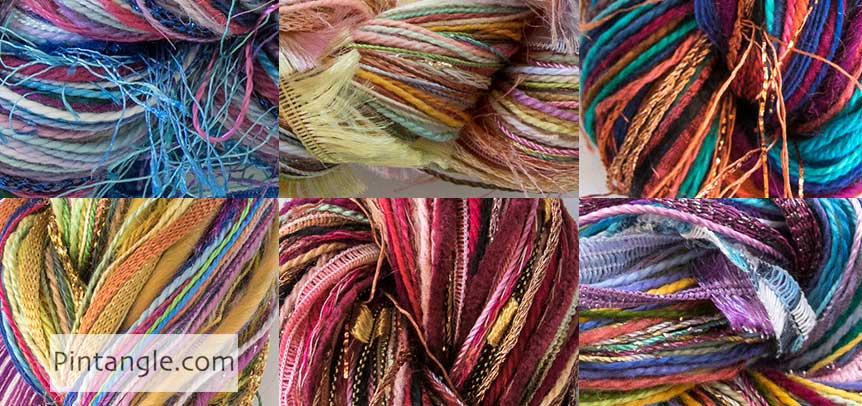
Experimenting with different threads can be expensive. You would normally have to buy a whole skein of each type of thread. My thread twisties are a combination of different threads to use in creative hand embroidery. These enable you to try out stitching with something other than stranded cotton. For the price of just a few skeins, you can experiment with a bundle of threads of luscious colours and many different textures.
These are creative embroiders threads. With them, I hope to encourage you to experiment. Each Twistie is a thread bundle containing silk, cotton, rayon and wool. Threads range from extra fine (the same thickness as 1 strand of embroidery floss) to chunky couchable textured yarns. All threads have a soft and manageable drape. Twisting them around a needle makes experimental hand embroidery an interesting journey rather than a battle. Many are hand dyed by me. All are threads I use. You may find a similar thread twist but no two are identical.
You will find my thread twisties in the Pintangle shop here.



Sharon, thank you for the precise and complete directions and pictures you provide for all the stitches. They are so helpful to those of us who struggle…everything is so clear. I so appreciate that you are helping me improve my stitches and learn new ones. I recently retired from teaching at 77, and am anxious to indulge in my love for embroidery. You are so kind to share your God-given talents and gifts with so many of us.
This is one of my favorite stitches. Thanks for this stitch in TAST.
My trials of bullion knot are here.
http://hobbysewing.blogspot.com/2020/09/tast-17-beyond-tast-17.html
2018 TAST Stitch #29: https://www.thecrafties.com/2018/12/tast-roundup-3/
I could’ve used more practice, but I have future projects in mind:D
-C
I love the praying mantis is there a pattern for that thankyou ..
Denney – the mantis was adapted from a pattern in an old inspirations magazine – like really old early 2000’s maybe. Sorry I can not be more precise but at the time I adapted it heavily
How to do curved bullion stitch required for petals or buds?
Surekha take a small bite of the fabric in step 1 so theat when the knot is complete it folds up on itself to form a loop- hope this helps
Conquered the bullion stitch!!! Thank you so much. I switched to a size 9 milliners needle ( I had avoided that needle because of the tiny eye, but the right threaded solved that problem) with my 12 wt. floss and my bullions are gorgeous. I ‘be been able to get up to 15 wraps so far.
Lynn that is wonderful news – the needle really does make a difference
Thankyou it’s lovely and so is that magazine lol
Here is my sample – http://hokkaidokudasai.blogspot.jp/2015/11/take-stitch-tuesday-19-bullion-knot.html
Thanks!
Trying to catch up with my stitches 🙂
My bullion knots:
Blog: http://hetkabinet.blogspot.nl/2012/06/tast-2012-24-20.html
Flickr: http://www.flickr.com/photos/hetkabinet/7371482622/
I used the bullion stitch to create Dragonflies over Cattails for my TAST sampler. I really like the effect of the stitch. See my work here
http://sparemomentstitching.wordpress.com/2012/05/23/tast-week-20-bullion-stitch/
I have really enjoyed stitching my little bullion garden. It is posted up on my blog: http://dinkydideequilts.blogspot.com.au/2012/05/bullion-garden.html
Was hoping that my first try with the bullion stitch wouldn’t be the embarrassment that it is:
http://harvestmoonbyhand.blogspot.com/2012/05/take-stitch-tuesday-bullion-knot-week.html
I certainly could use more practice with this one. http://quiltisland.blogspot.com/2012/05/bullion-rose-and-petunias.html
Hi Sharon, sorry this is late….been away on holiday………..
This is my sample for week 20 bullion stitch !
hugs chris richards
xxxxx
http://ellascraftcreations.blogspot.co.uk/2012/05/tast-week-20-bullion-stitch.html
Bullion Knots!
http://thetruevine.wordpress.com/2012/05/20/take-a-stitch-tuesday-bullion-knot/
I enjoyed working with stitch for the first time.
http://eclecticlamb.com/2012/05/20/week-20-tast-bullion-knot/
Forgot to tell you that I uploaded my bullionknot sample to stitching fingers: stitchinfingers.ning.com/photo/bullionknots
The link should be:
http://www.stitchinfingers.ning.com/photo/bullionknots
Sorry.
Hi Sharon
Here is my efforts on the bullion.
http://pippaquilts.blogspot.co.uk/
I stitched a few bullion knots to one of my TAST samplers. I wrote about it here:
http://fat-quarter.blogspot.com/2012/05/bullion-knots.html
I was late for the challenges,, 17,18 and 19.
But able to catch up 20.
I tried out a little flower design with this stitch.
Thankyou Sharon, i am happy doing all the stitches given by you here.
my little work can be seen
http://viji-crafts.blogspot.in/2012/05/tast-2012-week-20-bullion-knot.html
viji
I mixed Bullions with french knots and Button Hole flowers, and made a design for the letter J.
http://kathysnest32.wordpress.com/2012/05/20/tast-2012-week-20-bullion-knot-stitch/
??? ?????? ??????
http://flowerkaleidoscope.blogspot.com/2012/05/tast-201220-bullion-knot.html
My attempts of the Stitch:
http://summersofindia.blogspot.in/2012/05/bullion-knot-stitch-1.html
Thank you Sharon for giving us this opportunity . For people like me who juggle between work and home and constantly travelling, TAST is one thing which keeps me away from depression and loneliness. I always look forward to next challenge hoping to do something more than what I did before.
Yes many a time I may not be able to do much, but looking at others work motivates me and gives me many ideas.
http://yarngoddess.wordpress.com/2012/05/19/billions-and-billions-of-bullion-knots/
Thanks for another week of inspiration to everyone who posted here and on flickr and facebook.
Sorry I missed the last 4 weeks. But I’ve jumped back in again with the bullion knot.
http://playfulstitching.wordpress.com
I even managed to squeeze in two of the stitches that I missed.
I had fun with the bullion! You can see pics on my blog:
http://suztats.blogspot.ca/2012/05/tast-bullion-knot-and-cqjp.html
I attended a Brazilian Embroidery group recently and have since been practicing bullions so a very timely challenge – Thanks Sharon! You can see my example here http://creativedaily.blogspot.ca/2012/05/bullions.html
Hello
My bullion stitches are on my blog: http://dufall.blogspot.fr/
and on flickr: http://www.flickr.com/photos/severine14/7227373226/in/photostream
I really don’t like bullion knot… so I stitched something I don’t like …..
hello,
here is my project for this stitch.
http://pierrespapiersciseaux.blogspot.fr/2012/05/tast-semaine-20-le-point-de-poste.html
This challenge learns me a lot. In one hand, I learn new stitchs that I had never tried earlier, and in the other hand, the TAST forces me to be creative, to think outside the box, and to try new thinks.
Thank you very much Sharon !
Hi Sharon
Here my try of bullion stitch
http://artscraftsandmore-withveena.blogspot.in/2012/05/bullion-stitch-for-tast-2012.html
Here is my attempt on bullion knot.
http://withbrushandneedle.blogspot.in/2012/05/tast-12-week-20-bullion-knot.html
How ’bout that?! I finished my blog post. Kept it shor and sweet. If you didn’t know you could click on my name to find my blog, you can copy or click on this link:
http://theshopsampler.wordpress.com
I have posted my Bullion stitched tree and also used all previous stitches except Satin stitch.
If you should be kind and check, please take a cup of coffee as Mr WordPress stretched the details of the work and you may be grateful for the drink.
http://crazyqstitcher.wordpress.com/
An image of my bullions can be seen here:
http://stitchinfingers.ning.com/photo/wisteria-3?context=album&albumId=2105845%3AAlbum%3A429720
I’ll be blogging about it tomorrow.
I finally caught up!! I’ve posted Week 19, Half Chevron and Week 20, Bullion Knot here…
http://debbies-doings.blogspot.ca/
Thank you to Sharon and all the other stitchers who keep inspiring me with their wonderful work.
Thank God I finished it!!! First time trying Bullion knots….
http://stitchinfingers.ning.com/photo/tast-2012-bullion-knot-stitch?context=user
Thank you for tast! still my favorite time in the week!
http://stitchinfingers.ning.com/photo/ginger-biscuit-when-she-was-a-puppy?context=latest
only a small piece this week. hope you like it. thank you for doing this every week.
xx liz xx
I’ve posted my Bullion samples on my blog http://focus-on-fiber.blogspot.com
My examples, which I have done in the past are here:
http://karrinscrazyworld.blogspot.com/
I stitched some bullion pansies, here is the link:
http://threads-and-patches.blogspot.com/2012/05/tast-week-20-bullion-knot.html
love the wrapped bullion stitch~!
for a look at the latest on the christmas stocking project go to:
http://simpletosublimepapernapkinpoetry.blogspot.com/2012/05/tast-week-20-wrapped-bullion-stitch.html
thank you again Sharon. it’s been a fun learning experience for me to participate in TAST.
🙂
libbyQ
hello, here is my sample!
http://alovchany.blogspot.com/2012/05/20-tast-tast-week-20.html
I like this stitch even if I’m not well to do it. Here you can see my sampler http://j-en-revais.blogspot.com/2012/05/tast-20.html
Hi Friends, my post for the week 20. Thank you all!
http://embroiderland.blogspot.com.br/
and
http://stitchinfingers.ning.com/photo/if-i-catch-you?xg_source=activity
Hi Sharon,
till now I have tried escaping from this stitch, can’t run any more now, started my trials are here-
http://jizee6687.wordpress.com/category/tast-2012/20-bullion-knot/
Thanks,
Chitra
Hi,Sharon
My work is very simple.I´m still learning to do bullions perfectly.
http://stitchinfingers.ning.com/photo/jewelry?context=latest
Bonjour sharon ,
Voici ma participation …
http://foliesdesandrine.canalblog.com
Bonne fin de semaine
Sandrine
http://www.flickr.com/photos/stitchinwoman/
Here are my very shaky bullion columns.
Thanks Sharon, I had great fun with Bullion stitch, the tip about winding the thread clockwise was really helpful. I have not finished the brooch yet, but the stitching is all done, you can check it out here
http://www.flickr.com/photos/janekiwi/7213020430/in/photostream
I had great enjoyment working with the Bullion stitch.
http://web.me.com/queeniepatch/Queeniepatch_Quilts/Blog/Entries/2012/5/17_TAST_2012%2C_Week_20.html
http://stitchinfingers.ning.com/photo/tast-2012-week-20?context=user
Here is my work for TAST 2012 Weeks 14-20. LisaB
http://stitchinfingers.ning.com/photo/tast-2012-week-14-20-lisab?context=user
Here’s my really really poor attempt… http://thatyankstitches.multiply.com/journal/item/314/Take_A_Stitch_Tuesday_2012_Challenge_-_Week_20
A temari with bullion knots http://borduurblog.blogspot.com/2012/05/bullion-knot-stitch.html
http://christinaroland.blogspot.com/2012/05/tast-week-20.html Keeping up on Tast, but didn’t like this stitch. Looking forward to week 21.
My journal page is here
http://linsartyblobs.blogspot.co.uk/2012/05/tast-20.html
I stitched a few bullion knots with cotton a broder. I had trouble with them, but remembered your tip about wrapping the thread counter clockwise. Thanks! I wrote about it here:
http://fat-quarter.blogspot.com/2012/05/padded-surface.html
Here is my work on bullion stitch of this week’s tast.
http://nalinihandwork.blogspot.in/2012/05/tast-2012-week-20-bullion-stitch.html
thank u
Hello Sheron, hello everyone,
I go to Germany for a few days but I did not want to miss this stitch. So I had a long night 🙂
Here is my attempt: http://fabricfusion.blogspot.com/2012/05/tast-20-bullion-knot-stitch.html
Happy Stitching
Claudia
Not enough time this week to work the stitch, but I had done this flower the same week we did french knots 🙂
http://fanaticalseamstress.wordpress.com/2012/05/15/punto-rococo/
I enjoyed Bullions in the 2007 challenge – now, as with all my stitching, I need to wind the threads more evenly ….
http://www.flickr.com/photos/23261611@N04/4757763833/in/set-72157623763221568
How’d you know this was one of my favorite stitches, Sharon?! Better than the French Knot. Here’s my post: http://debbiesfiberwork.blogspot.com/2012/05/tast-week-20.html
I am so glad to get finally learn this stitch. I have wanted to for quite a while! You can see my start here
http://princessbubblescreates.blogspot.ca/
Here’s my weekly post with old samples:
http://fat-quarter.blogspot.com/2012/05/old-bullion-knots.html
I already planned to stitch bullion knots on my white cloth, so I’m glad it’s this week’s TAST stitch.
Would you like to see a starfish that somehow turned into a flower? 🙂
http://www.beading-arts.com/2012/05/tast-week-20-bullion-knot.html
Hi Sharon, this is my bullion knot stitch,
http://homemadebyme.tumblr.com/post/23105856273/tast-2012-week-20-bullion-knot-stitch-point
Wheat is my favorite cereal.
I have done a lot of knots lately, Bullion knot stitch was new to me when I started. Here is my Bullion knot page: http://ullabritt.wordpress.com/tast-2012/20-bullion-knots/
Had a funny feeling this would be the next stitch 🙂
Just finished!
http://www.flickr.com/photos/36140279@N03/7202208340/in/photostream
Barbara
Hi Sharon,
I posted a piece last week with bullion Agapanthus flowers.It doesn’t have a link back since it is a week old.
http://deepashome.blogspot.in/2012/05/flowers-and-more.html
Another old Brazilian embroidery piece
http://deepashome.blogspot.in/2010/06/brazilian-embroidery-beginners-sampler.html
I have subscribed to pintangle via email and also Take a Stitch Tuesday. Each time I do, it says I am already subscribed, but I never receive the information. Any help would be appreciated.
Sorry to hear you are having troubles Rita. There is only one subscription via the email link in the right hand margin. Have you checked your spam filter as it possibly going there. I have also written you an email